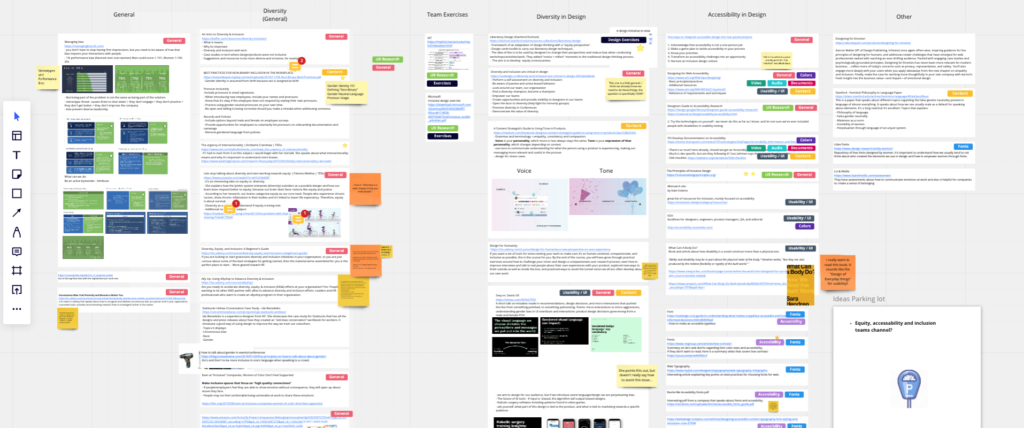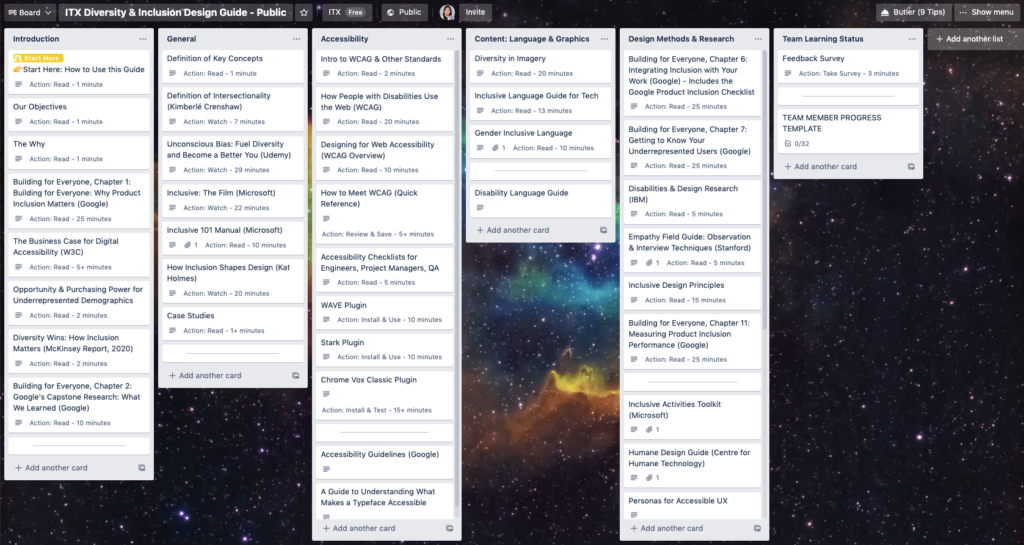Join us as we take a deliberate approach to learning about diversity, equity, and inclusion in product design
If the mission of User Experience is to create experiences that improve the lives of others, how can we allow the process we use to conceive these experiences, and ultimately the product or service themselves, to exclude whole segments of people? That is precisely what happens when we allow irresponsible design practices to deliver harm through the experiences we’ve helped create.
To begin to address these flaws, designers need education around inclusion, awareness of what inclusive design looks like, and a pathway to action that embeds inclusive practices into the design and development process.
In 2021, our team of UX designers initiated an intentional dialogue around diversity and inclusion within our work. This moved us to do what designers do: ask questions, conduct research, and spark conversations with a lot of people.
During our research, we learned that 62.3% of respondents to a 2020 InVision survey said they recently had a team conversation about diversity, equity, and inclusion at work. Of those who responded, 26.4% said it was the first time they had done so. Inspired to ensure we were doing our part, we created space to engage our team in those same conversations. A big part of that effort required self-reflection about our own contributions.
As designers, we play a critical role in the product development process and, ultimately, in building the world we all live in. Our decisions – big and small – have a considerable impact on the lives of so many.
Simply put, our designs can help people or hurt them. It’s our duty to ensure our designs are conceived and implemented responsibly and with inclusion top of mind.
The social benefit is clear and undeniable. In her video presentation entitled The Case for Product Inclusion 2.0 Google’s Head of Product Inclusion Annie Jean-Baptiste makes a strong case for supporting inclusion through design, which also embraces business considerations and impact.
Product Inclusion emphasizes universality. It’s the practice of applying an inclusive lens throughout the entire product design and development process to create better products and accelerate business growth.
Product Inclusion means inviting in those with diverse perspectives, learning from their perspectives, and then embedding them at key inflection points in the process to create products that serve a more diverse consumer base [1].

ITX’s Inclusive Design Initiative
Objective and Guiding Principles
So our design team at ITX posed the question: how might we ensure that everyone on our team (current and future) has a foundational set of knowledge and tools to design inclusive products?
And with that, we kicked off Phase 1 of an expansive, ongoing initiative. A small group of us set out to achieve the following objectives over a 3-month period:
- Establish a standard, baseline understanding of inclusion and how it applies to technology – specifically, digital products;
- Provide foundational information and tactics required to practice inclusive product design; and
- Empower the UX team to collaborate with our colleagues in Sales, Delivery, Product, and Architecture to advocate for and deliver products that are inclusive.
The following represent the four key principles we aligned around:
- Focused. Limit scope to the audience of the UX design practitioner and (mostly) to the practice of design.
- Impactful. See a tangible outcome within 3 months.
- Collaborative. Include as many perspectives in the process as possible.
- Scalable. Create something that can evolve and grow.
We first set out to understand how familiar our team was with the concept of inclusive design. We started with a basic survey to gauge our team’s level of experience with the subject matter and followed with several 1:1 interviews with team members to gather more detail.
Survey results confirmed our hypothesis; we learned that the depth of knowledge across the team varied. On an uplifting note, we also learned that team members highly valued inclusion and felt driven to learn more about it.
With that knowledge in hand, we launched a research phase. We scoured the broad expanse of the internet and vetted numerous resources. As I’m sure you’ll discover when you check out the outcomes of our initiative, there is a plethora of great stuff out there.
During the process, we leaned heavily on our objectives and principles to stay on track. We reminded ourselves that this was still Phase 1 and we had to start somewhere. Our goal was to roll something out and drive change as quickly as possible.
Tools That Support Our Collaborative Effort
Because of our rich experience with Miro and Zoom, we selected them as our preferred tools for collaboration and documentation. Our project sub-group conducted weekly working sessions and brought in other team members along the way to gather their input, too. In this way, we were implementing some of the product inclusion best practices we were researching.

An initial collection and organization of found resources in Miro
We compiled a set of quality, curated resources that we felt provided a strong introduction to Product Inclusion and that met the objectives we outlined for our team. We rounded them up into one neatly organized Trello board, called it a “Diversity & Inclusion Guide,” and rolled it out to our design team as required training.

ITX Diversity & Inclusion Design Guide in Trello
Crawl, Walk, Run Toward Continuous Innovation
Knowledge building is a deliberate, step-by-step process that begins with foundational education (as early on as possible). This was the logical starting point for our team. We believe strongly in continuous improvement through continuous learning. Every question we asked yielded new information, new knowledge, and confirmed the reality that the work we initiated will never be complete.
After each team member completed the learning guide, we surveyed the team again. And the results showed great promise:
- More than 80% of team members “learned a significant amount of new information (50-75% of the information was new) about inclusion.”
- 100% of team members answered ‘Yes’ to the question: “Do you think the information you consumed in this guide will change the way that you think about and approach design/technology problems in the future?”
Our confidence blossomed, knowing that the learnings were driving meaningful, positive impact.
Our next step, which has already begun, was to collaborate with the other departments in our organization (Development, Quality Assurance, Marketing, and Product Management) to ensure we’re all doing our part to build and ship inclusive products.
Our process of knowledge building is transitioning seamlessly into one of knowledge sharing. We are actively identifying training opportunities and process improvements.
The ITX Diversity & Inclusion Design Guide
In the spirit of collaboration, we invite you to check out a public version of our Diversity & Inclusion Guide. Some proprietary information has been removed or modified due to copyright, but most of the board consists of free, publicly available resources.
We hope that it inspires you to create, build, and ship more inclusive products, and to take the time to understand how your team might play a role in applying and expanding the concept of inclusion in design. Every opportunity we have to be better and to do better cannot be undervalued.
To complete the full learning guide, we recommend the following:
- Register for a Trello account (a free account is fine).
- Subscribe to Udemy to access the 2 Udemy courses we included.
- Pick up a copy of Building For Everyone: Expand Your Market With Design Practices, from Google’s Product Inclusion Team, to read the chapters we included.
- Set aside about 10 hours (estimated) to complete all the material.
[1] Building For Everyone: Expand Your Market With Design Practices, from Google’s Product Inclusion Team. September 1, 2020.
We’re knowledge seekers and knowledge sharers, and we’d love to have you join us. If you have thoughts about the Trello board or insight into how your team is taking action to build more inclusive products, we’d love to hear! Contact us.
Learn more about designing for inclusion with the ITX ebook
Getting Started with Product Inclusion – An imperfect guide to thinking bigger and building better digital experiences.

Christina Halladay is a User Experience (UX) Designer with an educational background in Psychology and a passion for ‘people’ problems. She’s driven to understand how things work and how they impact the people that interact with them. At ITX, she is a Director of UX where she works with distributed cross-functional teams to build impactful, human-centered digital products. She co-founded and organized a UX conference series called ITXUX, which brings world-renowned speakers to various cities to educate and inspire the tech community. When she’s not designing digital products, she can usually be found somewhere outside with her husband, son, and two dogs, being amazed by the design of the natural world.



